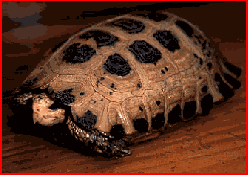|
In the wild, Indotestudo forsteni (sometimes referred to as Geochelone or Testudo travancorica) typically occurs in upland tropical forests where the humidity is high, although sometimes it is also found in drier conditions. It is most active during the early part of the rainy season (when breeding also occurs). This tortoise typically avoids strong sunlight, and does not normally seem interested in basking facilities (although, given its wide distribution, regional preferences may exist). As in the wild, peak activity is often seen following heavy, warm, summer rain. Daytime environmental temperature should be maintained in the 26 - 30°C region during summer (78 - 86 °F). In winter, daytime temperatures can be reduced to 24 °C (75 °F) . At night, temperatures can be reduced to around 18 °C (65 °F). A full spectrum light should be included in all terraria, and infra-red dull emitters are an appropriate source of heating. This tortoise regularly takes snails, slugs and worms in addition to green leafy material, fruit and vegetables. A bathing pool is essential, as Travancore tortoises are known to drink copiously and like to sit, half-submerged, for several hours at a time in warm, shallow pools. Regular spraying with slightly warm water has also proved beneficial to health and can also promote interest in breeding. Glass "fishtank" type accommodation is not appropriate for long-term maintenance - a large indoor pen in a high humidity zone is far more suitable. This can be provided with damp orchid bark and sphagnum substrate. In the wild, fallen fruits are believed to comprise a high proportion of its diet. Many keepers provide a diet rich in prepared meats such as dog food for this species, but this is probably inappropriate. Only a very small amount of low fat animal protein (such as rehydrated cat pellets with added vitamins and calcium) should be offered, and an occasional treat of live food such as zoophobas or waxworms may be accepted by some individuals. Do remember, however, that this is predominantly a herbivorous species.
|
|




